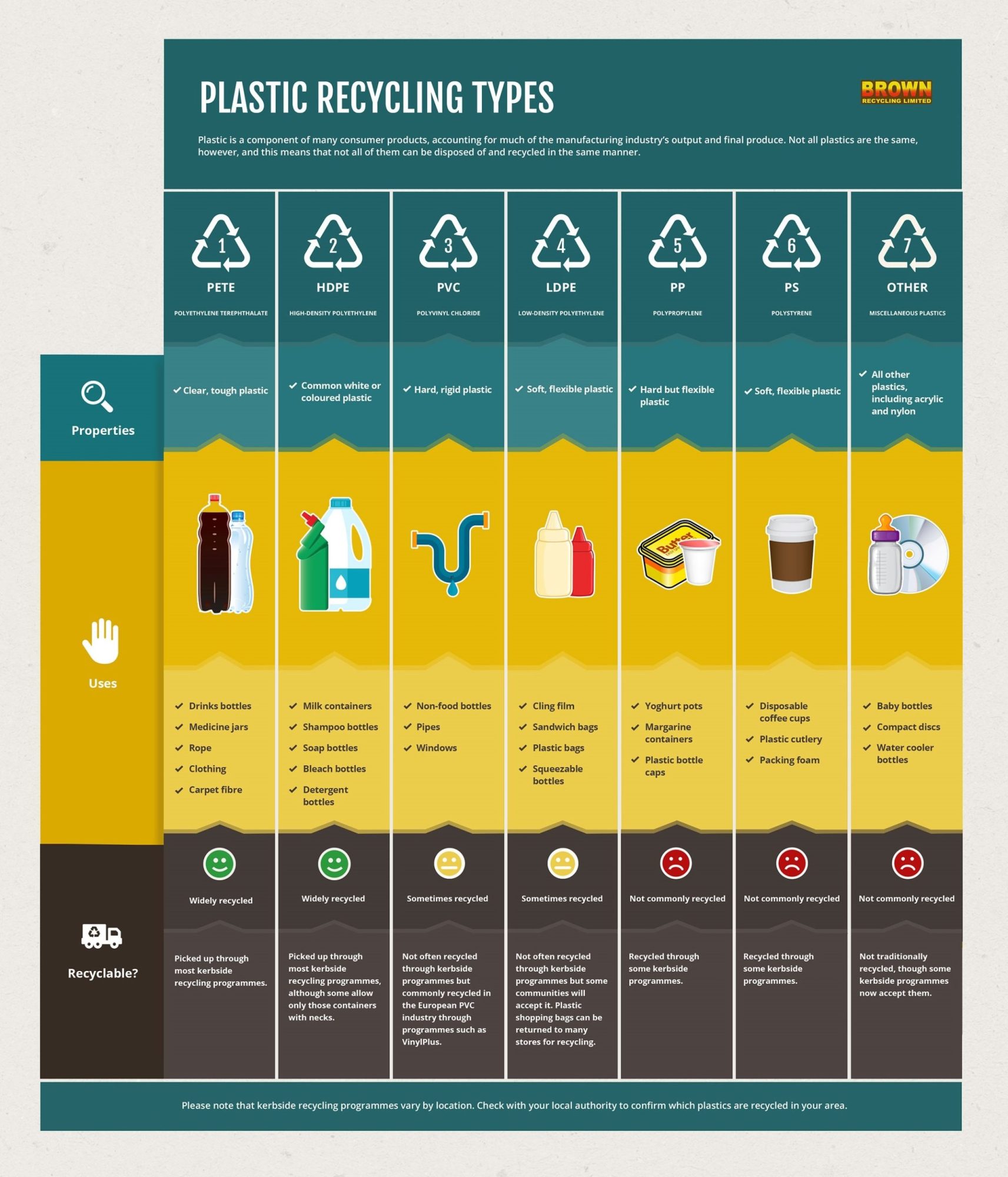
Plastic Recycling Codes – Article & Infographic
Plastic is a component of many consumer products, accounting for much of the manufacturing industry’s output and final produce. Not all plastics are the same, however, and this means that not all of them can be disposed of and recycled in the same manner.
On account of this, back in 1988 the Society of the Plastics Industry (SPI) created a classification system for the different types of plastic and how they should be recycled and disposed of depending on their chemical makeup. This system is designed to help consumers and recyclers with the task of disposing of each type of plastic correctly, and here we explain a little more about how the system works.
Brown Recycling have created an infographic to show the differences between the seven plastic identification codes. You can view the full resolution of the infographic here or take a look at our in-depth article below.
1: PETE (Polyethylene Terephthalate)
This plastic is susceptible to odours and flavours from food and drink that is stored within containers made from it. Objects made from this plastic are usually recycled and made into further products for future use.
General properties of PET include:
- hard and tough properties
- high heat resistance
- a clear appearance
- solvent resistant
- good gas and moisture barrier
- microwave transparency
Typical products made from PET plastic include beverage bottles, medicine jars, rope, clothing and carpet fibre.
2: HDPE (High-Density Polyethylene)
This plastic is extremely safe on account of its non-transmitting properties, meaning no harmful chemicals are transmitted into food or drinks within containers made from it.
HDPE’s general properties include:
- soft waxy surface
- permeability to gas
- excellent chemical resistance
- excellent moisture barrier properties
- hard to semi-flexible and strong
- HDPE films crinkle to the touch
Items made from HDPE plastic include milk containers, containers for motor oil, shampoos and conditioners, soaps, detergents and bleaches. It should be noted that though safe for use with food and drink, these containers should never be used to hold food or drink if this isn’t what they originally contained.
3: PVC (Polyvinyl Chloride)
Sometimes recycled, this plastic is harmful if ingested so should never come into contact with food or drink.
General properties of Polyvinyl Chloride include:
- excellent transparency
- good chemical resistance
- good weathering ability
- low gas permeability
- stable electrical properties
- long term stability
Though this plastic is most commonly found in plumbing pipes, it can be used for all kinds of pumps and tiles.
4: LDPE (Low-Density Polyethylene)
LDPE is sometimes recycled thanks to its characteristics as a healthy plastic which benefits from durability and flexibility.
General properties of LDPE include:
- tough and flexible
- waxy surface
- soft – scratches easily
- good transparency
- low melting point
- stable electrical properties
- good moisture barrier properties
Some products which use LDPE are things like cling-film, sandwich bags, squeezable bottles and plastic bags.
5: PP (Polypropylene)
Polypropylene is occasionally recycled. Thanks to its strength and high melting point, it can be used in a wide range of products.
General properties of PP include:
- excellent chemical resistance
- high melting point
- hard, but flexible
- waxy surface
- translucent
- strong
Products using polypropylene include objects such as yoghurt pots, margarine containers and even plastic bottle caps.
6: PS (Polystyrene)
Polystyrene is commonly recycled. The recycling process, however, is a particularly difficult one in relation to the other plastic types.
General properties of PS include:
- clear to opaque
- glassy surface
- rigid or foamed
- hard
- brittle
- high clarity
- affected by fats and solvents
Examples of polystyrene products include disposable coffee cups, plastic cutlery and packing foam.
7: OTHER (Miscellaneous types of plastic)
This classification within the plastics system accounts for all miscellaneous types of plastic not defined by the other six codes. Included in this category are acrylic and nylon, both of which are extremely difficult to recycle. Products using these products include baby bottles, compact discs and medical storage containers.
Brown Recycling are committed to doing our bit for the environment, which is why we know all about the importance of correct plastic recycling procedures. Adhering to our zero-to-landfill commitment whenever and wherever we can, we provide expert, reliable waste collection and recycling services to domestic and commercial customers throughout Stoke and the surrounding areas.
While not all types of plastic are recyclable, here at Brown Recycling, we are still able divert 98% of what we collect from landfill, using our RDF (Refuse Derived Fuel) facility. This turns waste products which cannot be recycled into a fuel for use in Energy from Waste facilities, so your plastics continue to be useful and don’t end end their lives in a landfill.
To find out more, or to arrange for one of our services at your property today, contact the friendly team of experts here at Brown Recycling. We’ll be happy to help, and will do what we can to ensure you and your premises are as environmentally friendly as can be.
This website uses cookies to enhance your browsing experience and deliver personalised ads. By clicking “Accept All Cookies”, you agree to the storing of cookies on your device to enhance site navigation, analyse site usage, and assist in our marketing efforts.

